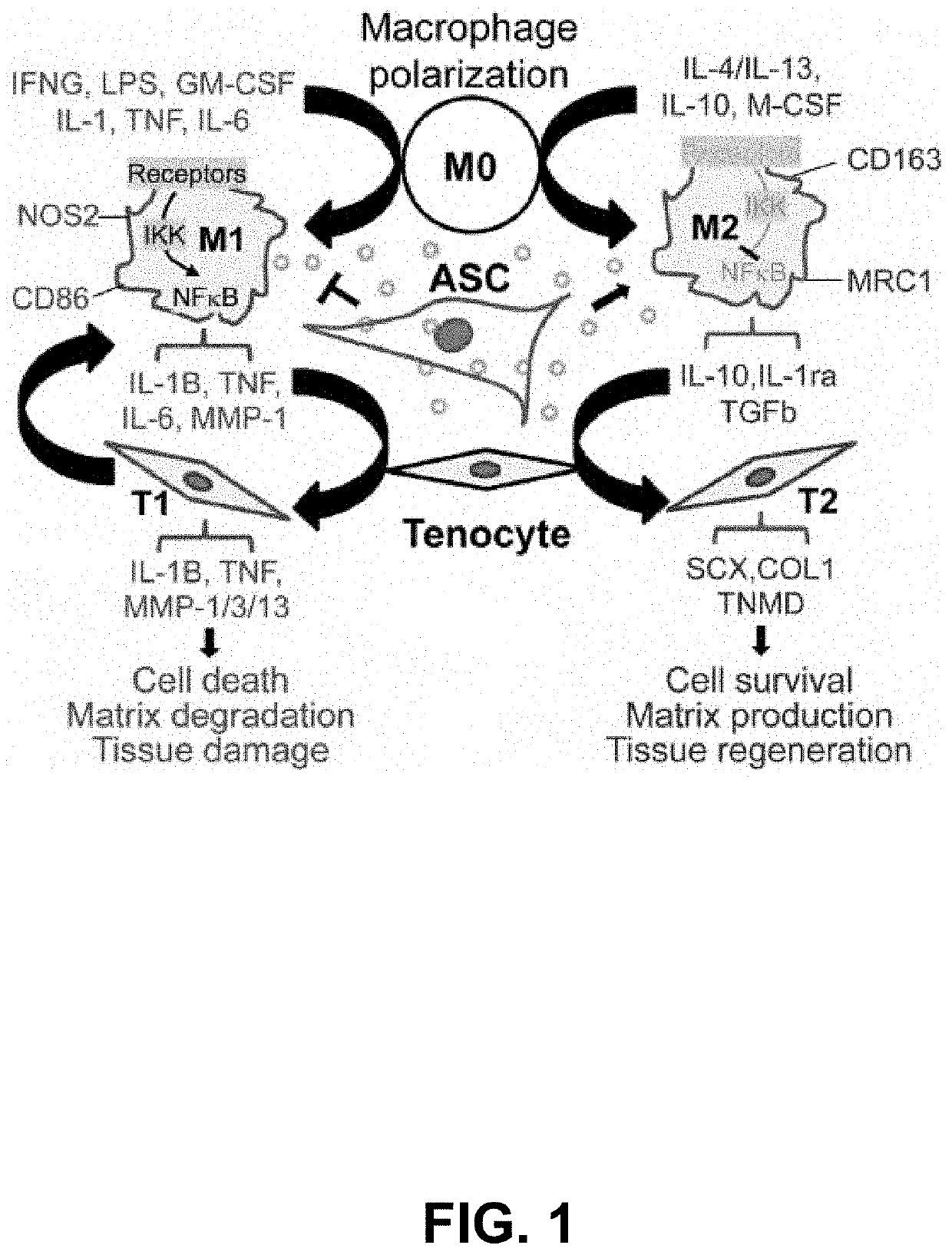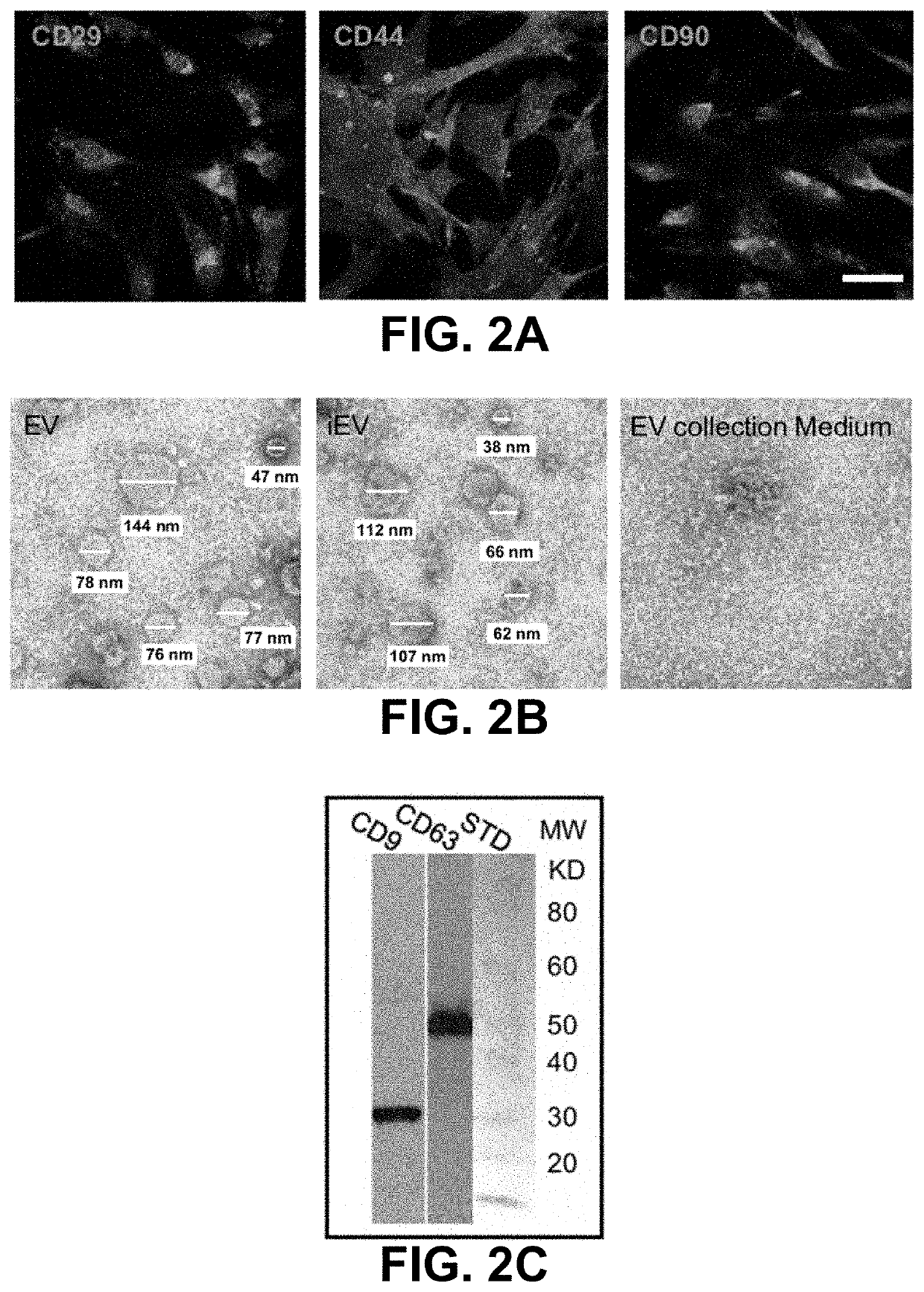Stem cell-derived extracellular vesicles and methods of use thereof
- Summary
- Abstract
- Description
- Claims
- Application Information
AI Technical Summary
Benefits of technology
Problems solved by technology
Method used
Image
Examples
example 1
ization of Mouse ASCs and ASC-Derived EVs
[0070]Mouse macrophages were derived from bone marrow of femurs and tibiae of adult NF-κB-GFP-luciferase (NGL) transgenic reporter mice for nuclear factor kappa-light-chain-enhancer of activated B cells (NF-κB) or wild type FVB / NJ (FVB) mice of both sexes and cultured in a macrophage culture medium containing 10% L929 cell conditioned medium (a source of macrophage colony stimulating factor), 100 unit / ml penicillin, 100 μg / ml streptomycin, and 10% fetal bovine serum in Minimum Essential Medium α. After 5 days, adherent cells were harvested and used for subsequent studies.
[0071]Mouse ASCs were isolated from the stromal vascular fraction of subcutaneous fat of adult ScxGFP or NGL mice of both sexes and expanded in ASC culture medium containing 10% FBS, 100 unit / ml penicillin, and 100 μg / ml streptomycin in α-MEM.
[0072]EVs were isolated from the conditioned medium of ASC culture. ASCs at passage 2-4 were primed with 100 ng / ml IFNγ overnight. The ...
example 2
the Role and Mechanisms of ASCs in Regulating Macrophage Polarization During Tendon Healing In Vitro and In Vivo
[0076]Macrophage polarization was induced and characterized. Mouse bone marrow-derived monocytes (M0) were induced into M1 and M2 macrophages by LPS+IFNγ and IL-4, respectively. As expected, among the three types of cells, the induced M2 macrophages expressed the highest level of a M2 marker MRC1, while the induced M1 macrophages produced the highest levels of IL1-β and PGE2 proteins (FIG. 3).
[0077]It was determined that ASCs facilitate M2 macrophages via a paracrine mechanism. In transwell culture, mouse ASCs induced the expression of the M2 marker MRC1 in macrophages in the absence (M0) or presence of M1 stimuli (M1; FIG. 4A). Consistently, in vivo study of a canine flexor tendon repair model revealed that ASCs, delivered in a form of thin sheet with collagen matrices, significantly increased the expression of a M2 stimulator gene IL-4 and a M2 marker gene CD163 in repai...
example 3
the Role and Mechanisms of ASC EVs in Regulating Macrophage Inflammatory Response During Tendon Healing In Vitro
[0078]In vitro studies were conducted with EVs produced by mouse ASCs. The impact of ASC EVs on the macrophage inflammatory response was evaluated in EV-macrophage co-culture. Macrophages were stimulated with the pro-inflammatory cytokine interleukin-1β (IL-1β). IL-1β was chosen because it was the most significantly induced pro-inflammatory cytokine detected in the mouse Achilles tendon after injury and repair. To assess the EV-specific effect, EV collection medium (Control) and EV-free conditioned medium from ASC culture (Medium) were used as controls. The macrophage inflammatory responses were assessed via the NF-κB-luciferase reporter expressed by the NGL mice for the NF-κB-responsive luciferase activity.
[0079]NGL macrophages (30,000 cells / cm2) were pre-treated with either one of the following: Control, Medium, or EV for 24 h (N=3 / condition). EVs were applied at a dose ...
PUM
 Login to View More
Login to View More Abstract
Description
Claims
Application Information
 Login to View More
Login to View More - R&D
- Intellectual Property
- Life Sciences
- Materials
- Tech Scout
- Unparalleled Data Quality
- Higher Quality Content
- 60% Fewer Hallucinations
Browse by: Latest US Patents, China's latest patents, Technical Efficacy Thesaurus, Application Domain, Technology Topic, Popular Technical Reports.
© 2025 PatSnap. All rights reserved.Legal|Privacy policy|Modern Slavery Act Transparency Statement|Sitemap|About US| Contact US: help@patsnap.com



